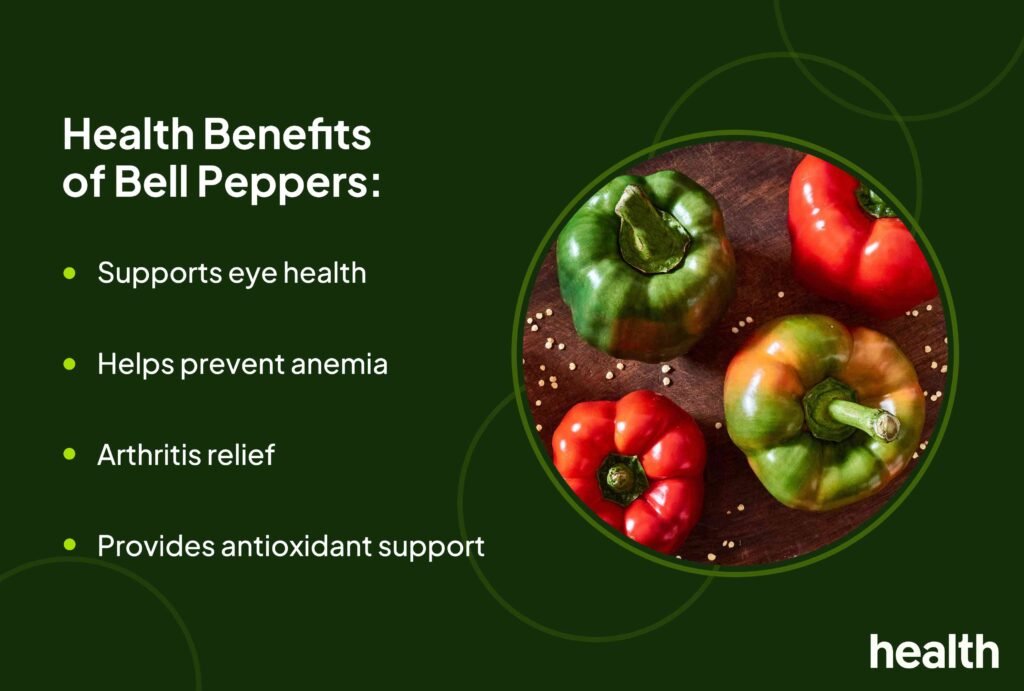Bell peppers (Capsicum annum L.) contain key nutrients that can support eye health and prevent anemia, among other benefits. They are members of the nightshade family and can be eaten raw or cooked.
Bell pepper color changes depending on its ripeness. Green bell peppers are the least ripe and have a slightly bitter flavor. Yellow, orange, purple, and red peppers (“sweet peppers”) are the ripest and sweetest.
Bell peppers are excellent sources of lutein and zeaxanthin, carotenoids that can benefit eye health.
What the research says: Research shows that daily lutein supplements can increase the macular pigment optical density (MPOD) and improve visual function in people with early signs of age-related macular degeneration (ARMD). Low MPOD is a significant risk factor for AMRD.
In general, a diet rich in lutein and zeaxanthin can reduce the risk of ARMD. Bell peppers are exceptionally high in these nutrients.
Anemia occurs when your blood has a reduced number of red blood cells or hemoglobin, the protein that helps your red blood cells transport oxygen from your lungs to the rest of your body. It’s a common diagnosis typically caused by iron deficiency.
One large red pepper contains 0.705 milligrams (mg) of iron, approximately 4% of the recommended intake for adult women and 9% for adult men. It also contains 210 milligrams of vitamin C—more than double the recommended daily amount. Vitamin C improves how the body absorbs plant-based iron.
Fresh bell peppers can be beneficial for people at risk for anemia, including young children, people who menstruate, and pregnant people.
Bell peppers are packed with antioxidants, including vitamin A and vitamin C, and beta carotene. These components help protect the body against cell damage and may help prevent certain inflammatory conditions, including some cancers, cardiovascular diseases, and neurological (brain or nervous system) disorders.
What the research says: All bell peppers can help reduce free radicals and oxidative stress, but yellow peppers seem to have the highest antioxidant activity of all the varieties. Free radicals are highly unstable, reactive molecules in your body. Your body has antioxidants to help neutralize them.
Bell peppers contain compounds, such as vitamin C and beta-cryptoxanthin, which have possible anti-inflammatory properties. They’re also rich in antioxidants, such as quercetin and luteolin.
What the research says: Bell peppers might help reduce inflammation and manage arthritis symptoms. They might reduce inflammation, thereby reducing the severity of symptoms and chronic (long-term) discomfort.
Try to include a variety of anti-inflammatory foods and follow the medical advice of your healthcare provider.
Bell peppers are mainly composed of water, but they contain many powerful nutrients that support health.
One large red bell pepper (164 grams) provides:
- Calories: 43
- Fat: 0.49 grams (g)
- Carbohydrates: 9.9 g
- Fiber: 3.4 g
- Added sugars: 0 g
- Protein: 1.6 g
- Iron: 0.71 milligrams (mg), or 9% of the Daily Value (DV)
- Vitamin A: 257 micrograms (mcg), or 29% of the DV
- Vitamin C: 210 mg, or 233% of the DV
- Vitamin E: 2.59 mg, or 17% of the DV
- Potassium: 346 mg, or 10% of the DV
- Folate: 75.4 mcg, or 19% of the DV
Different colors of bell peppers offer slightly different nutrition. For example, red bell pepper has more vitamin A, vitamin C, and folate than green bell pepper. It also has slightly more calories, fat, carbohydrates, fiber, and protein.
Bell peppers are generally considered safe for the average healthy adult. However, they may trigger side effects in some people. While extremely rare, some individuals are allergic to bell peppers. Studies have found that people with a pollen allergy may be sensitive to the compounds in bell peppers.
Consuming large amounts of bell pepper may cause gas or bloating due to its high fiber content. Be mindful of your portion sizes, and discuss any potential concerns with a healthcare provider or registered dietitian (RD).
Bell peppers can be enjoyed fresh or included in various recipes. Here are some tips:
- Add to various dishes: Toss bell pepper slices into salads, add to sandwiches, or mix into egg, pasta, or stir-fry dishes.
- Experiment with different colors: Green bell peppers taste more bitter, while yellow, red, orange, and purple peppers taste sweeter.
- Keep them fresh longer: Dry peppers before putting them in the refrigerator. Store them in an open mesh or plastic bag and place them in a low-humidity drawer.
- Soften their crisp texture: Sauté them in a pan with low-sodium seasonings.
- Stuff them: Stuff them with ingredients like rice, sautéed vegetables, and a protein source.
- Try grilling: Brush them with olive oil and place them directly on the rack. Grill them uncovered until the skins are charred and the flesh is tender. Remove them from the heat, wrap them in tin foil, and allow them to sit for approximately 15 minutes. You can remove the skin before eating.
- Try roasting: Cut them in half and roast them at 425 degrees Fahrenheit (218 degrees Celsius) until the skins are charred and wrinkled. Remove the skin before eating.

